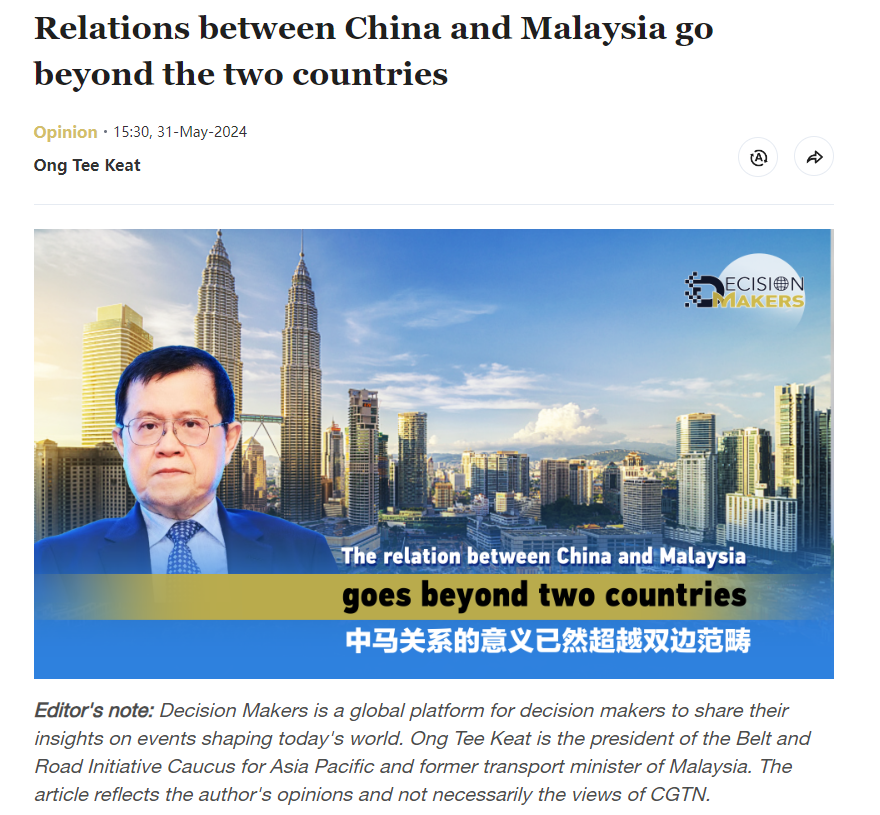LATEST INSIGHTS
Your Present Location: LATEST INSIGHTSOng Tee Keat: Relations between China and Malaysia go beyond the two countries
Source: CGTN Published: 2024-05-31

Last year, 2023, stood witness to a string of commemorative events relevant to the enduring relation between China and Malaysia.
Beyond the 10th anniversary of the roll-out of the Belt and Road Initiative (BRI) of which Malaysia is one of the earliest partners, the monumental 'Two Countries Twin Parks' in both countries remain the physical footprints of BRI's endeavor that has been keeping our memory of BRI afresh. Yet, the rich tapestry of bilateral cooperation wouldn't be complete without weaving the colored weft thread of the China-Malaysia Comprehensive Strategic Partnership as it marks a key milestone in the history of China-Malaysia diplomacy.
This was commemorated with the high profile visit to China by the Malaysian Prime Minister Datuk Seri Anwar Ibrahim in March 2023 during which a consensus was reached with Chinese President Xi Jinping on building a China-Malaysia community with a shared future. A blueprint was thus drawn up for the upcoming development of bilateral relations under the new leadership of Malaysia as both nations ushered in the golden jubilee anniversary of bilateral ties the following year. This signifies the growing maturity of the intertwined interest and shared aspirations of the two nations amid the new global dynamics. Yet, it means no malice to others as Malaysia has been traditionally staying above geopolitical rivalry since the old Cold War era.
Half a century ago, it was precisely this non-alignment diplomacy that propelled Malaysia into making a bold decision of engaging with China amid the Cold War face-off. The late Tun Abdul Razak Hussein, then Prime Minister of Malaysia, blazed the trail in ASEAN when he reached out to Beijing with an olive branch that culminated in the fostering of ties between the two nations of diverse political governance.
He was visionary enough to rise above the ideological schism in defiance of the then political correctness in rallying behind the West. Yet, his decision was squarely consistent with the Zone of Peace, Freedom and Neutrality (ZOPFAN) Declaration adopted by ASEAN in 1971 that underscored the collective intent of the bloc in creating a zone of peace, freedom and neutrality in Southeast Asia, 'free from any form or manner of interference by outside powers' and 'broadening the areas of cooperation.'
Bearing the DNA of broadening cooperation, Malaysia was instrumental in linking China to ASEAN when the then Chinese Foreign Minister Qian Qichen accepted Malaysia's invitation to attend the 24th ASEAN Ministerial Meeting in Kuala Lumpur in July 1991, thereby precipitating the engagement of China as ASEAN's first dialogue partner.
Fast forward, 30 years later, the evolving relation was further elevated to that of Comprehensive Strategic Partnership in 2021. Compounded by the strategic shift in its focus of diplomacy to ASEAN under the framework of neighborhood diplomacy ten years ago, China's model of partnership featuring amity, sincerity, symbiosis and inclusiveness is no doubt a refreshing alternative brought to the table of multilateral cooperation in Southeast Asia. The dividends accrued were translated into a tailwind upon which the BRI was riding to triumph in the region where Malaysia is one of the key beneficiaries.
As the BRI is entering its second decade of implementation with a gradual shift of pivot to sustainable infrastructure development and digital economy, it resonates with the current needs of Malaysia in seeking emerging industry cooperation which is underscored in its announced policies such as Industry 4.0, New Industrial Master Plan 2030, and Digital Economy Blueprint. Artificial Intelligence, Big Data analytics, and robotics amongst others, are being identified as emerging sectors having the potential to break new ground.
While China has continued to be the top trading partner of Malaysia for 15 consecutive years since 2009, the Malaysian exports have been undergoing a conspicuous changing trend. The share of electrical machinery and equipment in Malaysia's total exports to China increased from 33.3 percent in 2011 to 42.6 percent in 2022.
As of 2023, bilateral trade remained robust with China holding 17.1 percent of Malaysia's total trade. In the first quarter of 2024, trade with China further expanded 3.3 percent year-on-year to over RM112 billion (around $24 billion). As it is, the market prognosis continues to appear upbeat in anticipation of the conclusion of the ASEAN-China Free Trade Area 3.0 soon.
All eyes are now on Malaysia to conclude the deal as it is set to take over the ASEAN rotational chairmanship for 2025. While negotiating wider Chinese market access for ASEAN, perhaps lobbying for 'Chinese unilateral opening-up' in the spirit of Beijing's neighborhood diplomacy is a viable option to expedite the process under Malaysia's chairmanship. This will put the country's regional leadership role under test amid the prevailing geopolitical dynamics.
Alongside this, Malaysia has been known for its community building prowess, and the upcoming ASEAN Community Vision 2025 would perhaps provide the country with a good opportunity to augment China under its ASEAN chairmanship to realize the goal of creating a single market under the framework of ASEAN Economic Community (AEC).
This is reminiscent of the accession of non-ASEAN member states to such multi-lateral partnerships in the past as ASEAN plus three, ASEAN plus six and the Treaty of Amity and Cooperation in Southeast Asia (TAC).
In the present context, commemoration of the Golden Jubilee anniversary of China-Malaysia diplomatic ties is one to be viewed from a wider perspective. On the one hand, it spurs us on to explore new frontiers and dimensions for collaboration to meet rising aspirations in the interest of two countries. On the other hand, it reminds us of the past inspirational wisdom underpinning the proactive outreach to China by Malaysia – one in establishing the bilateral ties from scratch amid the Cold War confrontation, and the other in community-building resulting in ASEAN plus three and plus six on the threshold of globalization after the Cold War.























































































 京公网安备 11010802037854号
京公网安备 11010802037854号





